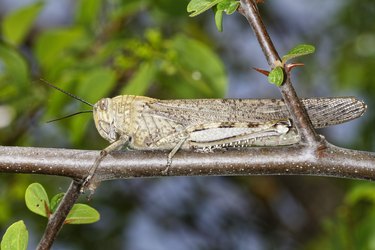
Locusts (family Acrididae) are insects that have plagued humans for literally thousands of years. They gather in huge swarms, devouring crops and decimating agricultural landscapes. Although locusts look like grasshoppers, their behavioral patterns are quite different. However, just like grasshoppers, their life cycle comprises three stages: egg, hopper, and adult.
What Is a Locust?
Video of the Day
Locusts are species of short-horned grasshoppers that are best known for forming massive swarms and destroying crops. They live on six continents, and there are around 27 species in total. They're herbivorous insects, eating the leaves and softer segments of plants and leaving behind very little. Unfortunately, they also love to eat grains (a staple of the human diet), which wreaks major havoc in the form of famine and starvation around the world.
Video of the Day
It can be easy to mix up a locust with a cicada or cricket, and locusts and grasshoppers look virtually the same with pointy antennae, a slim body, and big hind legs that make them excellent jumpers. However, unlike most grasshoppers, locusts undergo major physiological and behavioral changes when their population density is high.
Main Stages of Development
Locusts, like other insects, have three distinct stages in their life cycle: egg, hopper, and adult. Unlike houseflies and butterflies, they undergo incomplete or direct metamorphosis, which means there is no pupal stage, and juveniles look very similar to adults.
Eggs hatch in roughly two weeks, although the range is technically between 10 and 65 days. After they hatch, the nymphs (a younger, smaller version of an adult locust with no wings) get around by hopping, hence the term "hopper" stage. As the nymphs grow, they shed their skin a handful of times in phases known as instars. After the fifth instar, nymphs develop reproductive organs and wings.
Once they become sexually mature, locusts have officially entered their adult phase, during which they spend most of their time migrating and feeding. This phase lasts around eight to 10 weeks. All in all, locusts typically live anywhere between three and five months, although females may lay hundreds of eggs during this time.
Locust Behavioral Traits
Fascinatingly (and horrifyingly), locusts change their behavior when their population density increases. Biologists call this the insects' gregarious phase, and it typically happens when there's a lot of rainfall and they begin breeding like crazy. As soon as things start to get crowded, they migrate en masse to find food. During this period, the locust body transforms completely, with changes in color, shape, and physiology.
In the U.S., the American bird locust (otherwise known as an American grasshopper) eats a variety of plants, but, luckily, these locusts are rarely numerous enough to devastate crops on a mass scale. That said, if you do have crops or a garden of any kind, it's important to learn how to get rid of locusts using safe methods that won't harm the environment. These pesky insects can still cause some damage.